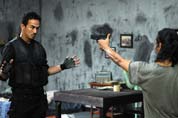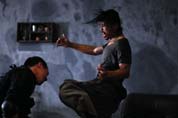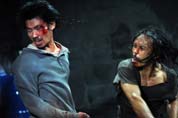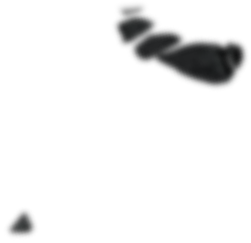“The best action movie in decades!”
About
As a rookie member of an elite special-forces team, Rama (Iko Uwais) is instructed to hang back during a covert mission involving the extraction of a brutal crime lord from a rundown fifteen-story apartment block. But when a spotter blows their cover, boss Tama (Ray Sahetaphy) offers lifelong sanctuary to every killer, gangster and thief in the building in exchange for their heads. Now Rama must stand in for the team’s fallen leader Jaka (Joe Taslim) and use every bit of his fighting strength – winding through every floor and room to complete the mission and escape with his life.
In 2007, director Gareth Huw Evans traveled to Indonesia to work on a documentary about the largely unfilmed martial art of Pencak Silat. As he shot, capturing the movements and styles of some of the grand masters of the art, he realized the untapped cinematic potential of what he was seeing.
One student in particular, a truck driver for an Indonesian telecom company named Iko Uwais, seemed to perfectly embody the idea that Evans was hatching.
“At first glance, he seems to be this quiet, shy, humble guy. But then he starts doing Silat and he completely transforms. What sets Iko apart is that he has a very solid understanding of what he looks like when he performs Silat. There is an aesthetic to it, where it is technically proficient, but there’s also something stylized about it – something cool.”
The director approached Uwais, and explained that he was set to return to Wales, but he promised to return so they would make martial arts films together. “He kind of was just saying ‘yeah, yeah’, not really believing a word I was saying,” laughs Evans. “But six months down the line we were back and in pre-production on Merantau.”
The film took its name from a centuries old Indonesian rite-of-passage. In the film, Uwais portrayed ‘Yuda’, a skilled practioner of Silat that leaves his family’s rural farm for a pilgrimage to the streets of Jakarta. There he becomes embroiled in a conflict between an innocent girl and the human trafficers that would sell her into slavery.
Merantau played to critical acclaim at film festivals around the globe – immediately building an interest in both Pencak Silat and a cinematic reteaming of Evans and Uwais. Through his new company – Merentau Films – Evans spent much of 2009 trying to gather financing for a project called Berandal – a thriller about a young Jakartan policeman named ‘Rama’- caught in a web of violence and intrigue in the criminal underworld. As delays piled up while waiting for investors, Evans conceived a daring Plan B: a prequel story that served to introduce Uwais as ‘Rama’ – but one that could be realistically financed by keeping the character confined to a single location.
Evans had long been a fan of such thrillers as Die Hard and Assault on Precinct 13 – films that used a single building for unyielding cinematic geography while creating feature-length tension. Evans and his partners at Merantau Films were quickly able to secure full funding for his stripped down vision, organizing the Indonesian production, promotion and distribution of the film – while partnering with XYZ Films as Executive Producers, allowing them to handle all International sales through their genre division, Celluloid Nightmares.
Rounding out the list of Executive Producers was Todd Brown, who had worked with Evans and Company on the release of Merantau – with Brown steering the film’s festival screenings and North American sales. When Evans was still in the planning stages of THE RAID: REDEMPTION, Brown was already in close communication regarding the tone of the film and marketing ideas.
“I remember very clearly when I realized that Uwais and Evans had found a special kind of chemistry,” recalls Brown. “It’s the kind that you are lucky to see every ten or fifteen years, if at all. I leapt at the chance to be involved with that first effort and then again with THE RAID: REDEMPTION. As far as I’m concerned I›ll be present to help Evans and Uwais in any way I can in any future projects as well.”
THE RAID: REDEMPTION provided a unique showcase for the choreography of Uwais and his Merantau collaborator Yayan Ruhian – allowing fight scenes that featured numerous combatants, distinct physical spaces and diverse weaponry as well as a full range of martial arts:
“We had always planned to introduce different fighting styles in the film,” says Evans. “To have every character be a practitioner of Silat is not only illogical, but can also become boring, limiting the techniques on display. We wanted to explore how different martial arts disciplines could clash against each other, like a game of chess, and see how each could overcome the strengths and weaknesses of their opponents.”
Months earlier, the director had been contacted via Facebook by Indonesian Judo champion Joe Taslim. His message congratulated Evans on the success of Merantau and the impact it would have on action films from that point forward. “I introduced myself as a Judo athlete and actor,” said Taslim. “I mentioned how I wanted to be involved in his next project, but I didn’t really expect to be taken seriously – not through Facebook. I was so surprised and excited when I got a reply.”
Initially, Evans had concerns about filling the role of ‘Jaka›, the Commander of the Special Forces unit who has a high level of discipline, professionalism and compassion towards the members of his force. The role required an equal balance of both acting and martial arts skills – but after Taslim’s audition – all of Evan’s concerns were put to rest.
“He just proved very natural with it,” says Evans. “He brought so much to the role. And with his Judo background, it would have been a dumb move on our part not to incorporate that in the choreography with his fight against our villain, ‘Mad Dog’. We had already established the groundwork for how the fight would play out, but then during practice sessions with Joe we’d start tailoring the fight to suit his strengths. We’d strip away at the Silat elements and play up to his upper body strength and his ability to quickly adapt, grapple and throw. Judo and Silat are two very different martial arts disciplines so it made for a fascinating duel with two masters going head to head in a fight to the death.”
For Co-Choreographer Ruhian, taking on the role of ‘Mad Dog’ and working with Taslim as a sparring partner was an unprecedented opportunity. The character, as written, is a psychotic killing machine – whose intense physicality makes him the most dangerous character in the film. While the fight between ‘Mad Dog’ and ‘Jaka’ comes comparatively early in the story – it is perhaps the films most pivotal sequence – establishing the severity of the situation that ‘Rama’ has found himself in.
“The choreography for that sequence is quite interesting,” says Ruhian. “I have a comparatively small body while Joe is a professional Judo athlete with a much bigger body mass. We tried to make it as exciting and dangerous as possible. All the throws, kicks and punches are based on real moves. No gimmicks, no tricks. It’s meant to be a thrilling fight between two killing fighters. We spent a great deal of time together, working to get it just right.”

















































